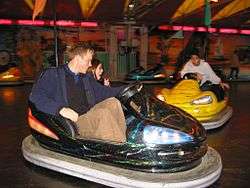Bumper cars
| Bumper cars | |
|---|---|
|
Bumper cars at a small town fair | |
| General statistics | |
| Vehicle type | Electric powered cars |
| Riders per vehicle | 1-2 |
Bumper cars (in the US) or dodgems (in other English-speaking countries) is the generic name for a type of flat ride consisting of several small electrically powered cars which draw power from the floor and/or ceiling, and which are turned on and off remotely by an operator.[1] They are also known as bumping cars and dashing cars.
The inventor was Victor Levand, who worked for G.E.
Design
Power is commonly supplied by one of two methods:
- The oldest and most common method uses a conductive floor and ceiling, each with a separate power polarity. Contacts under the vehicle touch the floor while a pole-mounted contact touches the ceiling, forming a complete circuit.
- A newer method uses alternating strips of metal across the floor separated by insulating spacers, and no ceiling grid.[2] The alternating strips carry the supply current, and the cars are large enough so that the vehicle body can always cover at least two strips at any one time. An array of brushes under each car make random contact with whatever strip is below, and the voltage polarity on each contact is sorted out to always provide a correct and complete circuit to operate the vehicle.
- The bumper cars on the Quantum-class cruise ships run on batteries. This avoids the conductive floor/ceiling of the traditional bumper cars setup, as the SeaPlex venue is to be readily convertible from a bumper cars ride to a multipurpose gym (basketball court). The disadvantage is that these ships' bumper cars take several hours to recharge their batteries.

The metal floor is usually set up as a rectangular or oval track, and graphite is sprinkled on the floor to decrease friction. A rubber bumper surrounds each vehicle, and drivers ram each other as they travel. The controls are usually an accelerator and a steering wheel. The cars can be made to go backwards by turning the steering wheel far enough in either direction, necessary in the frequent pile-ups that occur.
Although the idea of the ride is to bump other cars, safety-conscious (or at least litigation-conscious) owners sometimes put up signs reading "This way around" and "No (head on) bumping."[3][4] Depending on the level of enforcement by operators, these rules are often ignored by bumper car riders, especially younger children and teenagers.
During their heyday, from the late 1920s to 1950s, two major US bumper cars brands were Dodgem by Max and Harold Stoehrer and the Lusse Brothers' Auto-Skooter by. Joseph and Robert 'Ray' Lusse.[5][6] In the mid 1960s, Disneyland introduced hovercraft-based bumper cars called Flying Saucers, which worked on the same principle as an air hockey game; however the ride was a mechanical failure and closed after a few years.
The current largest bumper cars floor is located at Six Flags Great America in Gurnee, Illinois, and is called the Rue Le Dodge (Rue Le Morgue during October for Fright Fest). The ride is 51 feet (16 m), 9 inches by 124 feet 9 inches (38.02 m) or a total of 6,455 square feet (599.7 m2). A replica of the ride was built at California's Great America in Santa Clara; in 2005, however, a concrete island was added to the middle of the floor to promote one-way traffic, reducing the floor area and restoring Rue Le Dodge at Six Flags Great America's largest floor title. Six Flags Great Adventure's Autobahn is the largest bumper car floor but it has not operated since 2008.
See also
Gallery
- A decorative painting of some bumper cars
 Bumper cars at Taunus Wunderland
Bumper cars at Taunus Wunderland Bumper cars in Frankfurt
Bumper cars in Frankfurt Adult bumper cars at Genting Highlands
Adult bumper cars at Genting Highlands Bumper cars in Angeles City
Bumper cars in Angeles City A bumper car in motion at the Royal Adelaide Show
A bumper car in motion at the Royal Adelaide Show
References
- ↑ Gussow, Seth (November 1997). "Going Bump In The Night". Automobile Magazine. Retrieved 8 December 2013.
- ↑ "How does this Electric Floor work?". physicsforums.com. Retrieved 2014-08-31.
- ↑ Dolan, Maura (January 1, 2013). "Ruling over bumper-car injury supports amusement park". Los Angeles Times. Retrieved 8 December 2013.
- ↑ "A Guide To The Rides". Santa's Village Jefferson, New Hampshire. 2013. Retrieved 8 December 2013.
- ↑ (Multiple authors). "Legend/History". Lusse Auto Scooter Bumper Car Web Site. Lusse Auto Scooters, LLC. Retrieved 6 September 2014. Includes many details about Dodgem as well.
- ↑ Stanton, Jeffrey (1997). "Coney Island: Independent Rides". Coney Island History Site. Westland. Retrieved 6 September 2014.
External links
| Wikimedia Commons has media related to Bumper cars. |
